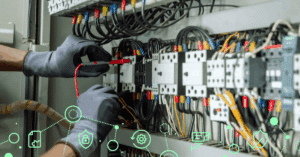How Universities Can Mitigate IoT Security Risk

Cybercriminals have educational institutions in their crosshairs. In fact, the education sector saw a 44% increase in cyber-attacks in 2022 compared to 2021. Due to the proliferation of IoT devices on college campuses, malicious actors have more access to your systems than ever before. It’s why IoT security risk measures are vital in the digital era.
IoT—or the Internet of Things—comprises high-tech gadgets that share information over the web. Your security cameras, smart thermostats, LED lights, campus alert systems, and more: all these are technically IoT devices. They do wonders—we can’t imagine life without them—but they leave the door open to cyber criminals when left unprotected.
Let’s unpack everything university leaders need to know about their IoT security risk measures, why they’re so vulnerable, and what they can do to strengthen their defenses.
The State of IoT Security Risk in Higher Education Institutions
Because of their broad user population, decentralized architecture, and open nature, college campuses present unique sets of cybersecurity risks. The network must support tens of thousands of wireless devices simultaneously. Furthermore, that network spreads across several campuses, locations, and departments.
They say all roads lead to Rome. The more roads, the more paths one can take. An abundance of IoT technology spread across college campuses provides hackers with infinite access points—infinite routes into the city. Unfortunately, all they need is one. Cybercriminals can exploit IoT security risk gaps to deploy spyware, ransomware, or steal sensitive information.
There’s a reason 74% of attacks on higher education have been successful. Comparatively, only 68% of attacks on businesses, 61% on healthcare, and 57% on the financial sector work in the hacker’s favor. Higher education also sports the slowest recovery time after an attack. About 40% take over a month to recover—against a global average of 20%. But why?
Why are Higher Education Institutions Becoming a Target for Cybercriminals?
You’ll see stories about cyberattacks on Fortune 500 companies and financial institutions in the movies or on the news. They’re flashy; they make headlines. It’s high risk, high reward. But in reality, most cybercriminals know how hard these institutions are to breach. They’d rather prey on easier targets.
Universities operate on vast networks to share knowledge in real-time. They also harbor a plethora of sensitive assets, from personal student and faculty data to financials, research, and government information.
Sprawling networks full of IoT security risk gaps make them a prime target. Many universities maintain legacy systems for their cybersecurity needs. Most prioritize convenience over safety. Think of how many devices are connected to the network at once.
Higher education also finds itself in a regulatory bind. They’re subject to laws regarding freedom of information. Therefore, compliance frameworks can hinder their best cybersecurity efforts.
What Makes University Cybersecurity So Treacherous?
Higher education faces many challenges and roadblocks to addressing its IoT security vulnerabilities—but in particular, it’s their hesitancy to invest in robust cybersecurity measures that makes them vulnerable. Whether it’s due to budget constraints or limited resources, many universities operate on outdated software.
Universities were among the first to embrace the internet age fully. It made learning more efficient. Cybercrime wasn’t as prevalent back then, so they got comfortable. Meanwhile, cybercriminals got sophisticated. Now, it can be near-impossible to tell a phishing scam from a legitimate email. Data breaches can give them access to sensitive information without you ever knowing they were there.
In addition, every student likely uses their own private laptop on campus. While it’s convenient, it poses a high degree of cybersecurity risk. It’s also difficult to enforce network usage policies when everyone uses their personal computer.
Most Common Cyber Attacks in Universities
Identifying the most common cyber threats is the first step in mitigating them. Let’s unpack the top three cyberattacks your institution likely faces.
Phishing
These email scams will look like innocent, run-of-the-mill messages. Cybercriminals excel at mimicking your trusted partners. Then, they use that trust to obtain your personal information. For colleges, most attackers will target students and faculty to get login information.
For example, a student gets regular emails from TheirSchool@university.edu. Then, one day, they get a message saying they’re locked out of their account for security reasons. But, if they follow the link below and enter their username and password, they can get back in.
This is a phishing scam. If they look closely, they’ll see the email came from TheirSchoool@university.edu. Notice the three ‘o’s in the scammer’s email.
Ransomware
In a ransomware attack, scammers install malicious software onto your network that holds your sensitive information hostage. Unless you pay the ransom—which is usually financially devastating—they’ll threaten to delete or release your school’s sensitive information. Ransomware attacks can compromise your system, hurt your reputation, and freeze operations.
SQL Injections
An SQL, or a structured query language, is when an attacker enters a piece of malicious code into a query box on the university website. The most common query boxes are contact forms and login pages. You can imagine how many of these exist across your network! The SQL injection gives them access to protected data. They can even alter the data or delete it altogether.
Benefits of Robust Inventory and Visibility of Connected Devices
Universities rely on a vast network of IoT devices to conduct their operations. Visibility into those assets is crucial to maintaining a safe learning environment. Let’s unpack five reasons why enhanced asset visibility is critical to mitigating IoT security risks.
Better Risk Management
When IoT assets are properly tracked, university leaders can reduce security risks significantly. This is equally important in the cloud, since securing what you can’t see is challenging. Blindspots in the cloud can pose further risks to your institution.
Frequent Updates
Heightened visibility identifies outdated software and devices and updates them to their latest, most secure versions. With a plethora of data, IT teams can verify that all IoT assets have the appropriate cybersecurity tools.
Level Playing Field
Heightened visibility identifies outdated software and devices and updates them to their latest, most secure versions. With a plethora of data, IT teams can verify that all IoT assets have the appropriate cybersecurity tools.
Easily Identify Unauthorized Access
Increased visibility also tells you what should and shouldn’t be there. When campus IT teams notice a foreign device, they can move more swiftly to prevent that device from accessing the network.
Set Asset Hierarchy
Not all IT assets are created equal. Visibility into your connected devices shows which ones contain the most sensitive information. From there, campus IT can categorize these assets by their operational function.
Quick Tips on IT Asset Management for Higher Education Institutions
With so many challenges and vulnerabilities, IoT security and asset management can sound daunting. With these quick tips, you can kickstart your journey toward a more visible IT environment.
- Simplify Your Asset Check-Out Process: Students and faculty need to use many school-owned devices. Overcomplicating the check-out process makes tracking those devices harder than necessary.
- Keep a Maintenance Schedule: Don’t wait for IoT assets to enter ‘obsolete’ territory before updating them. Staying on top of maintenance and updates will prevent security gaps from widening.
- Keep Tabs on Digital Assets: You likely use a third-party SaaS asset to conduct daily operations. Pay attention to all software licensing information and updates within your asset management system.
- Form a Contingency Plan: Develop an action plan in case of a data breach. Define clear roles and rules for all involved, and don’t hesitate to stress-test your network to prepare adequately.
A Special Note on Securing IoT Devices on University Campuses
Every extra IoT device adds a new degree of risk to the network. Even specific apps (such as TikTok) can pose heightened security risks. The number of connected IoT devices is growing rapidly as new technology comes to market.
According to Perry Alexander, director of the Information and Telecommunication Technology Center at the University of Kansas, nearly 30 billion autonomous IoT devices could be on their networks within two short years. Those are 30 billion entry points attackers could use to infiltrate your network—30 billion roads into Rome.
Many experts believe IoT security risk management comes down to one word: intent. How do students intend to use the network? Once you define intent, it becomes easy to recognize access requests that seem out of place.
Speaking of ‘out of place,’ IT asset visibility tells you when an asset is physically not where it should be. Ensure your campus IT teams are the ones who install IoT devices across the property. Doing so gives them the power to determine the safest locations for IoT assets. They’ll also know when they didn’t put one somewhere.
TikTok on University Campuses
You can’t turn on the news today without hearing about banning TikTok. What sounded outlandish only a few years ago is now the center of public discourse as we’ve learned how vulnerable American user data has become to the Chinese government. Data aside, studies have found that the average user spends 95 minutes daily on TikTok.
Universities are well aware of the danger TikTok poses to their data. Several have already moved to ban the app. For example, Louisiana’s state superintendent of education suggested TikTok be removed from public devices and blocked on school-issued devices. Auburn University has already blocked it for all students and faculty on campus.
There are several steps campus IT teams can take to mitigate TikTok’s impact on cybersecurity. Consider enrolling all student and faculty devices in a device management console. Your IT team can prompt users to follow campus rules by pushing enrollment policies; if you’re not enrolled, you can’t access campus WiFi.
From there, the team can ‘blacklist’ apps and websites (like TikTok) deemed unsafe for campus life. While connected to WiFi, users can’t access blacklisted apps and websites.
IoT security risk experts like Asimily have implemented strategies to track and block TikTok at scale. Asimily enables full visibility into all IoT devices, apps, and connections across your university’s network. They can increase the security profile of your campus network by prioritizing the top 2% of vulnerabilities (including TikTok usage), which amounts to 75%-80% of risks.
Strengthen your IoT Security Risk Measures with Asimily
Robust IT asset inventory management is crucial for universities. They’re the number one target for cybercrime due to their abundance of sensitive information and lax security measures.
If you’re looking for 100% network visibility across all devices, connections, applications, and services, then Asimily is the IoT security partner you’ve been searching for. At Asimily we:
- Provide 100% visibility into all devices and connections of any category or type, including IoT and specialized lab, research, and medical devices across your campus.
- Enable you to focus on the top 2% of vulnerable devices, amounting to 75%-80% of risks.
- Allow you to manage your vulnerabilities twice as fast.
- Require only two hours of vulnerability remediation—compared to 12 hours with other providers.
Get in touch with Asimily today to ensure your campus is safe and secure from all cyber threats. Our dedicated team of IoT security risk experts will keep your students, faculty, and data protected.
Reduce Vulnerabilities 10x Faster with Half the Resources
Find out how our innovative risk remediation platform can help keep your organization’s resources safe, users protected, and IoT and IoMT assets secure.




